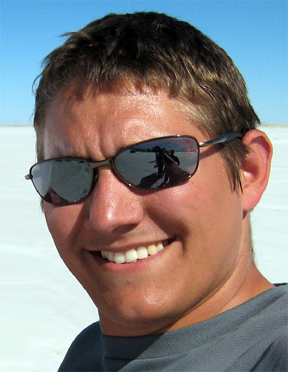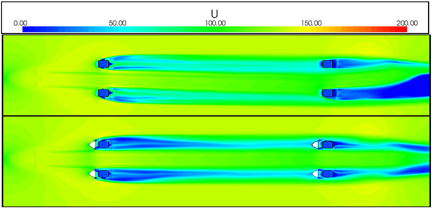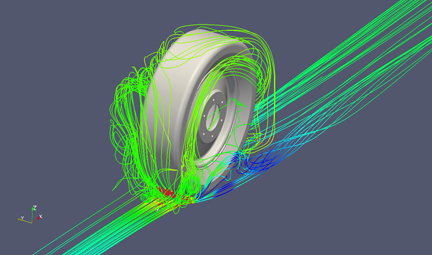Grad student leverages supercomputer to fine-tune aerodynamics
Columbus, Ohio (July 21, 2011) – Building a battery-powered land speed vehicle capable of achieving a speed of 400+ miles per hour requires innovative components, corporatepartnerships, hours of diligent preparation and a powerful supercomputer.
 |
|
Giorgio Rizzoni
|
A team of engineering students at The Ohio State University’s (OSU) Center for Automotive Research (CAR) recently began running aerodynamics simulations at the Ohio Supercomputer Center (OSC), one of the first steps in the long and careful process of designing, building and racing the fourth iteration of their record-breaking, alternative-fuel streamliner.fluctuations.
“The third generation electric land speed record vehicle to be designed and built by OSU students, the Buckeye Bullet 3, will be an entirely new car designed and built from the ground up,” noted Giorgio Rizzoni, Ph.D., professor of mechanical and aerospace engineering and director of CAR. “Driven by two custom-made electric motors designed and developed by Venturi, and powered by prismatic A123 batteries, the goal of the new vehicle will be to surpass all previous electric vehicle records.”
In 2004, the team achieved distinction on the speedway at Bonneville Salt Flats in Wendover, Utah, by setting the U.S. electric land speed record at just over 314 mph with the original Buckeye Bullet, a nickel-metal hydride battery-powered vehicle.
 |
| Carey Bork |
Several years later, the team returned with the Buckeye Bullet 2, a completely new vehicle powered by hydrogen fuel cells, and set the international land speed record for that class at nearly 303 mph. The team then replaced the power source, once again, using the same frame and body with a new generation of lithium-ion batteries and set an international electric vehicle record in partnership with Venturi Automobiles and A123 Systems at just over 307 mph.
“OSC has been a partner of the Buckeye Bullet team throughout the project’s history,” said Ashok Krishnamurthy, OSC interim co-executive director. “We’ve been extremely pleased to provide computational resources and technical assistance to the student engineers as they learn valuable computational science skills that they can easily transfer to careers in the automotive industry and elsewhere.”
This spring, the Buckeye Bullet team, again in partnership with Venturi and A123 Systems, began the development process for a completely re-engineered vehicle designed to break the 400-mph mark. In consideration of that blistering speed, one of the first critical aspects the team had to consider was the aerodynamic design of the vehicle.
“This goal places the team in direct competition with many of the fastest internal combustion cars in the world,” said Cary Bork, chief engineer for the team and an OSU graduate student in mechanical engineering. “What sets the new design apart from the previous Buckeye Bullet vehicles is that at these higher speeds it is possible to produce shock waves under the vehicle. Such shock waves under the vehicle negatively affect the vehicle drag and can produce lift. Lift is undesirable in this application. Minimizing or eliminating these shock waves is critical to ensuring the safety and stability of the vehicle.”
For both versions of the Buckeye Bullet 2, student engineers ran aerodynamics simulations on OSC computer systems to compliment studies of physical models tested in wind tunnels. However, the current team quickly found that wind tunnels with a “rolling-road” component required to test land-bound vehicles at the target speeds don’t exist. Rizzoni and Bork, therefore, leveraged the flagship IBM 1350 Opteron Cluster at OSC to run extensive simulations, initially focusing on validating performance of Buckeye Bullet 2 and eventually giving shape to the lean, new streamliner.
“We’re using computational fluid dynamics (CFD) to design and optimize the vehicle shape,” said Cary Bork, a graduate student and chief engineer for the project. “The simulations are needed to accurately predict the aerodynamic forces on the vehicle at these speeds and can only be run on large computing clusters. Various mesh sizes have been used from 1 million to 50 million cells. Most of the simulations use 25 million cells.”
In addition to an overall optimization of the body and fin shape, the new aerodynamic design features several additional areas of improvement over its predecessors. The vehicle will incorporate a layout where the driver is placed forward of the front tires to improve volume utilization, reduce overall vehicle length, decrease the vehicle drag by five percent and improve the vehicle balance. Also, the team is studying the addition of wind deflectors beneath the vehicle and in front of the tires to decrease the amount of air that enters the wheel well, thereby reducing drag as much as 14.9 percent. Finally, the team is studying simulations of new air-brake equipment to determine the system’s effect on vehicle stability.
Most of the CFD design is being completed using OpenFOAM, a free, open-source software package, and meshing is done using OpenFOAM’s automated utility snappyHexMesh. Vehicle geometry for the vehicle is being generated using Catia solid modeling and surfacing software, while post-processing is performed using Paraview. Some additional CFD testing also will be completed using Fluent software for comparative purposes. The team has brought on the Dublin, Ohio, firm TotalSim LLC, a frequent collaborative partner of OSC, as a technical partner and CFD consultant.
The Buckeye Bullet team plans to complete the design process by the end of the summer and spend the upcoming academic year constructing and testing the vehicle. Then, in Fall 2012, the students intend to return to the Bonneville Speedway to unveil yet another record-setting Buckeye Bullet.
The Ohio Supercomputer Center OSC) addresses the rising computational demands of academic and industrial research communities by providing a robust shared infrastructure and proven expertise in advanced modeling, simulation and analysis. OSC empowers scientists with the vital resources essential to make extraordinary discoveries and innovations, partners with businesses and industry to leverage computational science as a competitive force in the global knowledge economy, and leads efforts to equip the workforce with the key technology skills required to secure 21st century jobs. For more, visit www.osc.edu.
The Center for Automotive Research is an interdisciplinary research center in The Ohio State University’s College of Engineering. CAR research focuses on: advanced electric propulsion and energy storage systems for reduced fuel consumption and emissions; advanced engines and alternative fuels; intelligent transportation systems and autonomous vehicles; noise, vibrations and dynamics; vehicle chassis systems; and vehicle and occupant safety. For more, visit car.osu.edu.


